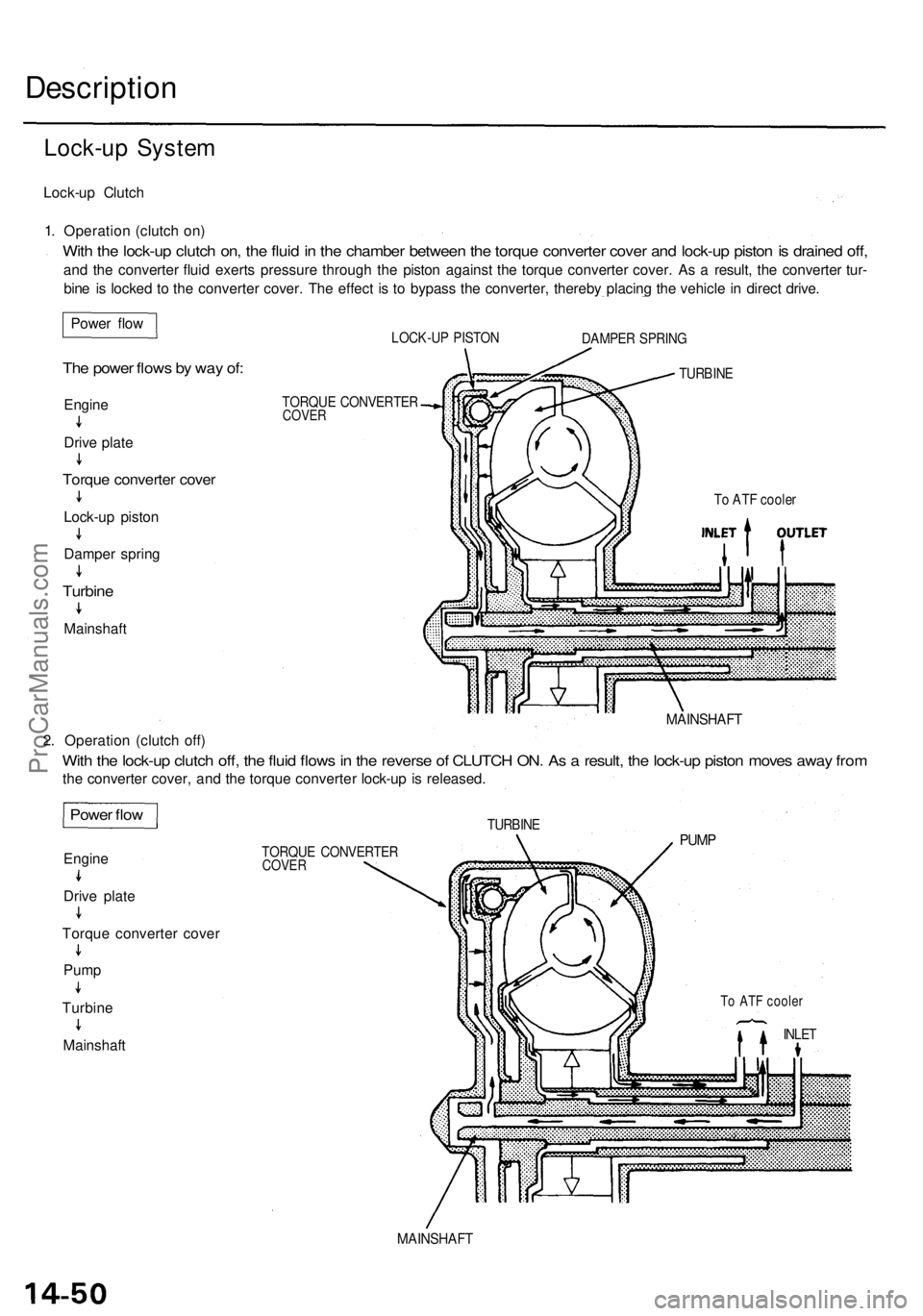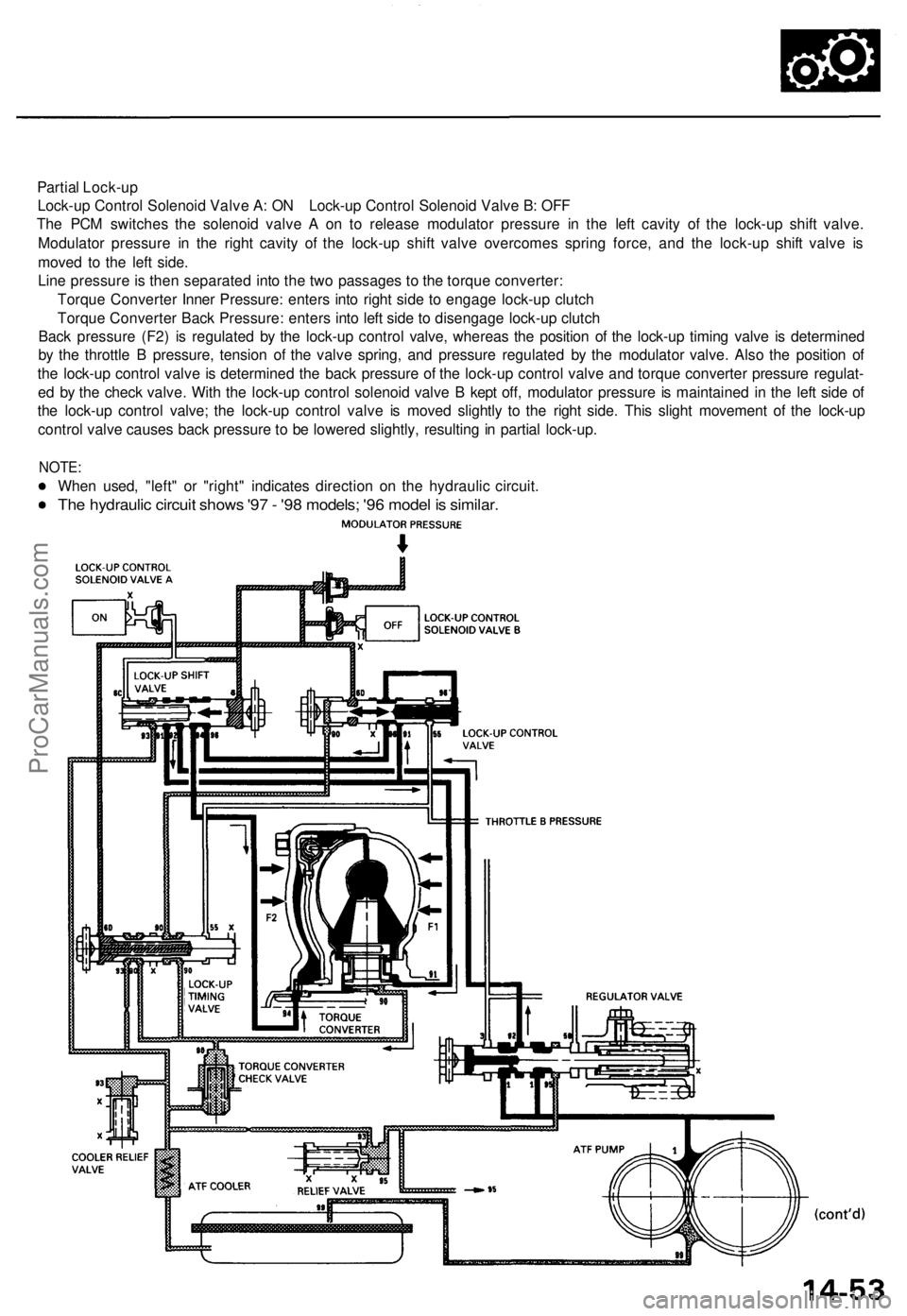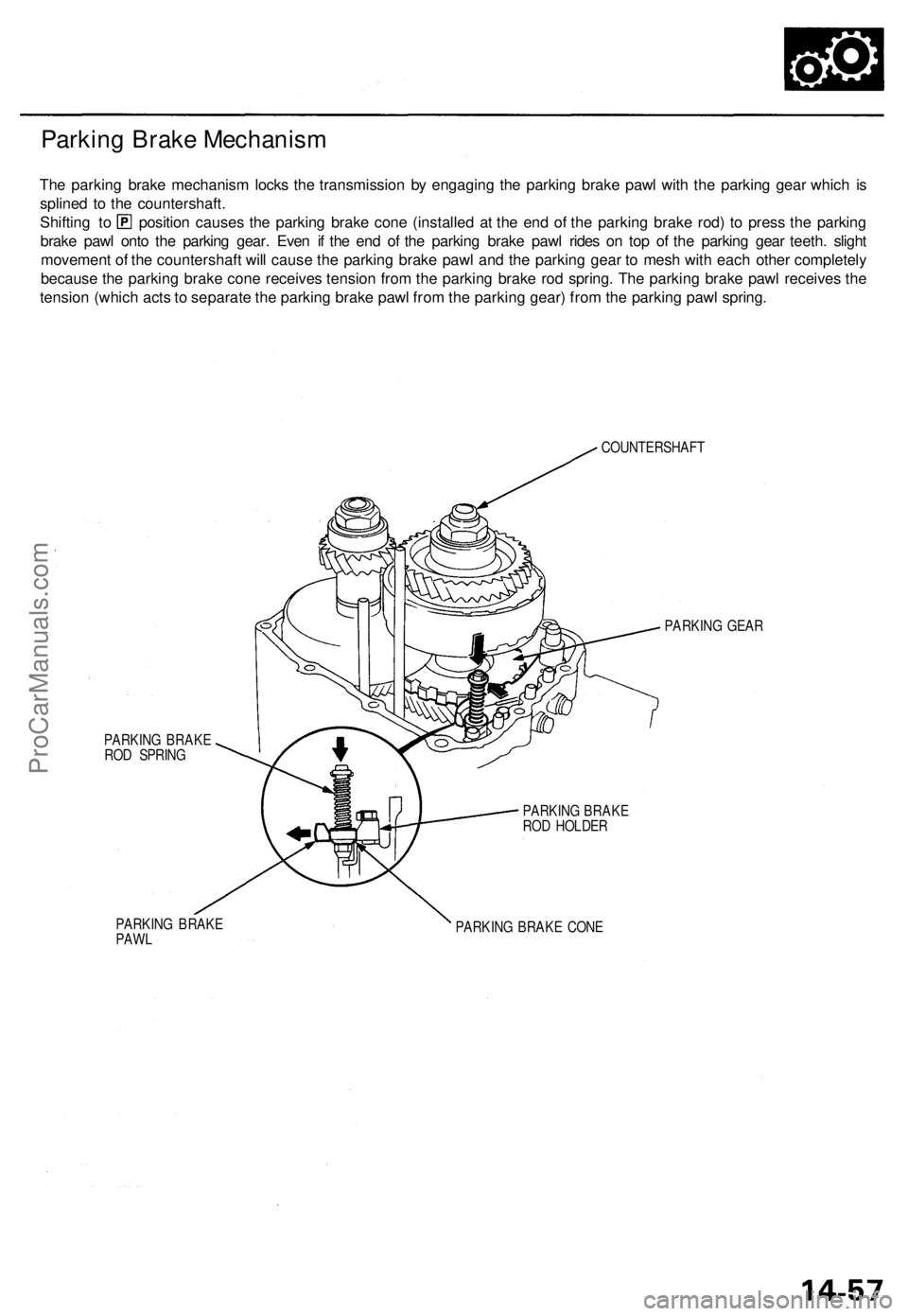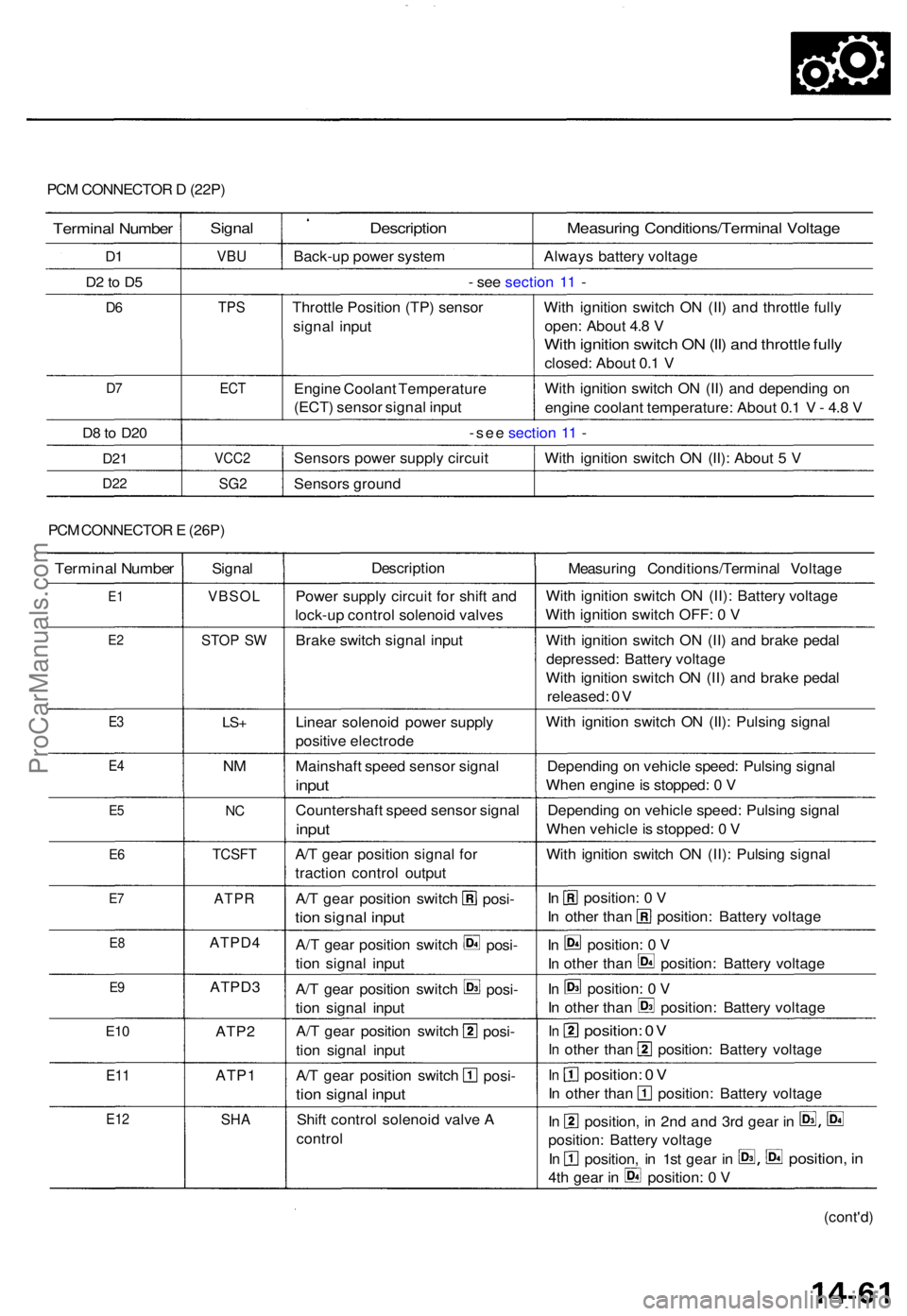Page 293 of 1771

Description
Lock-up System
Lock-up Clutch
1. Operation (clutch on)
With the lock-up clutch on, the fluid in the chamber between the torque converter cover and lock-up piston is drained off,
and the converter fluid exerts pressure through the piston against the torque converter cover. As a result, the converter tur-
bine is locked to the converter cover. The effect is to bypass the converter, thereby placing the vehicle in direct drive.
LOCK-UP PISTON
TORQUE CONVERTER
COVER
TURBINE
DAMPER SPRING
To ATF cooler
TURBINE
PUMP
To ATF cooler
INLET
TORQUE CONVERTER
COVER
2. Operation (clutch off)
With the lock-up clutch off, the fluid flows in the reverse of CLUTCH ON. As a result, the lock-up piston moves away from
the converter cover, and the torque converter lock-up is released.
MAINSHAFT
Power flow
The power flows by way of:
Engine
Drive plate
Torque converter cover
Lock-up piston
Damper spring
Turbine
Mainshaft
Power flow
Engine
Drive plate
Torque converter cover
Pump
Turbine
Mainshaft
MAINSHAFTProCarManuals.com
Page 295 of 1771
Description
No Lock-up
The pressurized fluid regulated by the modulator works on both ends of the lock-up shift valve and on the left side of the
lock-up control valve. Under this condition, the pressures working on both ends of the lock-up shift valve are equal, and
the shift valve is moved to the right side by the tension of the valve spring alone. The fluid from the pump will flow
through the left side of the lock-up clutch to the torque converter; that is, the lock-up clutch is in OFF condition.
NOTE:
When used, "left" or "right" indicates direction on the hydraulic circuit.
The hydraulic circuit shows '97 - '98 models; '96 model is similar.
Lock-up System (cont'd)ProCarManuals.com
Page 296 of 1771

Partial Lock-up
Lock-up Control Solenoid Valve A: ON Lock-up Control Solenoid Valve B: OFF
The PCM switches the solenoid valve A on to release modulator pressure in the left cavity of the lock-up shift valve.
Modulator pressure in the right cavity of the lock-up shift valve overcomes spring force, and the lock-up shift valve is
moved to the left side.
Line pressure is then separated into the two passages to the torque converter:
Torque Converter Inner Pressure: enters into right side to engage lock-up clutch
Torque Converter Back Pressure: enters into left side to disengage lock-up clutch
Back pressure (F2) is regulated by the lock-up control valve, whereas the position of the lock-up timing valve is determined
by the throttle B pressure, tension of the valve spring, and pressure regulated by the modulator valve. Also the position of
the lock-up control valve is determined the back pressure of the lock-up control valve and torque converter pressure regulat-
ed by the check valve. With the lock-up control solenoid valve B kept off, modulator pressure is maintained in the left side of
the lock-up control valve; the lock-up control valve is moved slightly to the right side. This slight movement of the lock-up
control valve causes back pressure to be lowered slightly, resulting in partial lock-up.
NOTE:
When used, "left" or "right" indicates direction on the hydraulic circuit.
The hydraulic circuit shows '97 - '98 models; '96 model is similar.ProCarManuals.com
Page 297 of 1771
Half Lock-up
Lock-up Control Solenoid Valve A: ON Lock-up Control Solenoid Valve B: ON
Modulator pressure is released by the solenoid valve B, causing modulator pressure in the left side of the lock-up control
valve to lower.
Also, modulator pressure in the left cavity of the lock-up timing valve is low. However, throttle B pressure is still low at
this time, so the lock-up timing valve is kept on the right side by the spring force.
With the lock-up control solenoid valve B turned on, the lock-up control valve is moved somewhat to the left side, causing
back pressure (F2) to lower. This allows a greater amount of fluid (F1) to work on the lock-up clutch to engage it. Back
pressure (F2), which still exists, prevents the clutch from engaging fully.
NOTE:
When used, "left" or "right" indicates direction on the hydraulic circuit.
The hydraulic circuit shows '97 - '98 models; '96 model is similar.
Description
Lock-up System (cont'd)ProCarManuals.com
Page 298 of 1771
Full Lock-up
Lock-up Control Solenoid Valve A: ON Lock-up Control Solenoid Valve B: ON
When the vehicle speed further increases, throttle B pressure is increased in accordance with the throttle opening.
Throttle B pressure (55) flows to the right side of the lock-up timing valve and the lock-up control valve, and they are moved
to the left side. The lock-up timing valve covers the port leading the torque converter pressure (90) from the torque convert-
er to the lock-up control valve. The lock-up control valve uncovers the port to leak torque converter pressure (94) and (96).
As this takes place, the torque converter back pressure is released fully, causing the lock-up clutch to be engaged fully.
NOTE:
When used, "left" or "right" indicates direction on the hydraulic circuit.
The hydraulic circuit shows '97- '98 models; '96 model is similar.ProCarManuals.com
Page 299 of 1771
Description
Lock-up System (cont'd)
Deceleration Lock-up
Lock-up Control Solenoid Valve A: ON Lock-up Control Solenoid Valve B: Duty Operation
The PCM switches solenoid valve B on and off rapidly under certain conditions. The slight lock-up and half lock-up regions
are maintained to lock the torque converter properly.
NOTE:
When used, "left" or "right" indicates direction on the hydraulic circuit.
The hydraulic circuit shows '97 - '98 models; '96 model is similar.ProCarManuals.com
Page 300 of 1771

Parking Brak e Mechanis m
Shifting t o
brak e paw l ont o th e parkin g gear . Eve n i f th e en d o f th e parkin g brak e paw l ride s o n to p o f th e parkin g gea r teeth . sligh t
movemen t o f th e countershaf t wil l caus e th e parkin g brak e paw l an d th e parkin g gea r t o mes h wit h eac h othe r completel y
becaus e th e parkin g brak e con e receive s tensio n fro m th e parkin g brak e ro d spring . Th e parkin g brak e paw l receive s th e
tensio n (whic h act s t o separat e th e parkin g brak e paw l fro m th e parkin g gear ) fro m th e parkin g paw l spring .
COUNTERSHAF T
PARKIN G BRAK E
RO D SPRIN G
PARKIN G BRAK E
PAW L PARKIN
G GEA R
PARKIN G BRAK E
RO D HOLDE R
PARKIN G BRAK E CON E
positio n cause s th e parkin g brak e con e (installe d a t th e en d o f th e parkin g brak e rod ) t o pres s th e parkin g
Th
e parkin g brak e mechanis m lock s th e transmissio n b y engagin g th e parkin g brak e paw l wit h th e parkin g gea r whic h i s
spline d t o th e countershaft .
ProCarManuals.com
Page 302 of 1771

PCM CONNECTO R D (22P )
Termina l Numbe r
D1
D 2 to D 5
D6
D7
D 8 to D2 0
D21
D2 2
Signa l
VBU
Descriptio n
Back-up powe r syste m
Measurin g Conditions/Termina l Voltag e
Always batter y voltag e
- se e sectio n 1 1 -
TP S
EC T
Throttl e Positio n (TP ) senso r
signa l inpu t
Engin e Coolan t Temperatur e
(ECT ) senso r signa l inpu t Wit
h ignitio n switc h O N (II ) an d throttl e full y
open : Abou t 4. 8 V
Wit h ignitio n switc h O N (II ) an d throttl e full y
closed : Abou t 0. 1 V
Wit h ignitio n switc h O N (II ) an d dependin g o n
engin e coolan t temperature : Abou t 0. 1 V - 4. 8 V
-se e sectio n 1 1 -
VCC 2
SG2
Sensor s powe r suppl y circui t
Sensor s groun d Wit
h ignitio n switc h O N (II) : Abou t 5 V
PC M CONNECTO R E (26P )
(cont'd )
Termina l Numbe r
E1
E2
Signa l Descriptio
n
Measuring Conditions/Termina l Voltag e
Powe r suppl y circui t fo r shif t an d
lock-u p contro l solenoi d valve s
VBSO L
STOP S WBrak e switc h signa l inpu t
E3
E 4
E5
E 6
E7
E 8
E9
E1 0
E1 1
E1 2SH A
ATP 1
ATP2
ATPD
3
ATPD 4
ATPR
TCSF T
NC
NM
LS +Linea r solenoi d powe r suppl y
positiv e electrod e
Mainshaf t spee d senso r signa l
input
Countershaf t spee d senso r signa l
input
A/T gea r positio n signa l fo r
tractio n contro l outpu t
Shif t contro l solenoi d valv e A
contro l Wit
h ignitio n switc h O N (II) : Batter y voltag e
Wit h ignitio n switc h OFF : 0 V
Wit h ignitio n switc h O N (II ) an d brak e peda l
depressed : Batter y voltag e
Wit h ignitio n switc h O N (II ) an d brak e peda l
released : 0 V
Wit h ignitio n switc h O N (II) : Pulsin g signa l
Dependin g o n vehicl e speed : Pulsin g signa l
Whe n engin e is stopped : 0 V
Dependin g o n vehicl e speed : Pulsin g signa l
Whe n vehicl e is stopped : 0 V
Wit h ignitio n switc h O N (II) : Pulsin g signa l
posi -
posi -
posi -
posi -
posi -A/T gea r positio n switc h
tion signa l inpu t
A/T gea r positio n switc h
tion signa l inpu t
A/T gea r positio n switc h
tio n signa l inpu t
A/ T gea r positio n switc h
tio n signa l inpu t
A/ T gea r positio n switc h
tio n signa l inpu t
position , i n
position : 0 V
4t h gea r i n
position
, i n 2n d an d 3r d gea r i n
position : Batter y voltag e
In
Inposition , i n 1s t gea r i n
position
: Batter y voltag e
I n othe r tha n
Inposition : 0 V
In
In othe r tha n
position
: 0 V
position : Batter y voltag e
In
I n
othe r tha n
position : 0 V
position : Batter y voltag e
position
: Batter y voltag e
I n othe r tha n
position
: 0 V
In
In
I n
position : 0 V
othe r tha n position : Batter y voltag e
ProCarManuals.com